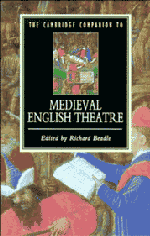Book contents
- Frontmatter
- 1 An introduction to medieval English theatre
- 2 The theatricality of medieval English plays
- 3 The York cycle
- 4 The Chester cycle
- 5 The Towneley cycle
- 6 The N-Town plays
- 7 The non-cycle plays and the East Anglian tradition
- 8 The Cornish medieval drama
- 9 Morality plays
- 10 Saints' plays
- 11 Modern productions of medieval English plays
- 12 A guide to criticism of medieval English theatre
- Select bibliography
- Continued Series List
- Index
5 - The Towneley cycle
Published online by Cambridge University Press: 28 May 2006
- Frontmatter
- 1 An introduction to medieval English theatre
- 2 The theatricality of medieval English plays
- 3 The York cycle
- 4 The Chester cycle
- 5 The Towneley cycle
- 6 The N-Town plays
- 7 The non-cycle plays and the East Anglian tradition
- 8 The Cornish medieval drama
- 9 Morality plays
- 10 Saints' plays
- 11 Modern productions of medieval English plays
- 12 A guide to criticism of medieval English theatre
- Select bibliography
- Continued Series List
- Index
Summary
Almost certainly the most anthologised of all medieval English dramatic pieces is the so-called Second Shepherds' Play, containing the double story of Mak the sheep-stealer and the visit of the shepherds to Bethlehem. Through this public exposure, not only the play but the 'name' of the author also has become familiar – 'The Wakefield Master'. Not everyone who knows of the Second Shepherds', however, will automatically connect it with the thirty-two short plays (better called 'pageants') that together make up the Towneley cycle, or realise that it is not so much the 'second' as an alternative Shepherds' pageant: Alia eorundem (another of the same). Even knowing the relationship between the pageant, the Wakefield Master and the Towneley cycle does not, however, take you very far; why, for example Wakefield Master, but Towneley cycle?
'Wakefield' refers to the smallish industrial town in what used to be the West Riding of Yorkshire, once the centre of the extensive medieval manor of Wakefield. Since early in this century it has been claimed, with varying degrees of certainty, as the original home and place of performance of this cycle of pageants (76, p. xxxv; 75, p. xxviii). As the York play was to York, so, it was said, the Towneley cycle was to Wakefield. The name 'Wakefield Master' was hence created as a convenient reference name for the anonymous author of a strikingly original group of pageants within the cycle.
- Type
- Chapter
- Information
- The Cambridge Companion to Medieval English Theatre , pp. 134 - 162Publisher: Cambridge University PressPrint publication year: 1994
- 1
- Cited by

